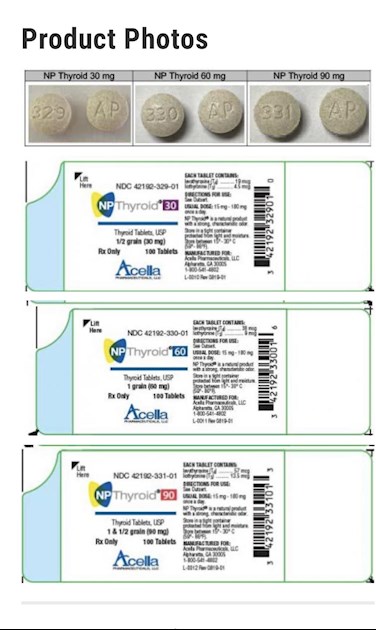When you say there’s no such thing as levothyroxine T4 why does this product have it on their label? Thanks
Levo v Levothyroxine : When you say there’s no... - Thyroid UK
Levo v Levothyroxine

So, you've replied to my comment by starting a new thread, rather than replying on the original thread. It's lucky I saw this! If you look at my reply, here, you'll see just underneath a blue oblong with 'Reply' written on it. To reply to someone, you click on that, and then the person concerned will be notified that you've replied. 
So, in reply to your next question, what you have there, the photo of the box, is not Armour. It's NP Thyroid. Both Armour and NP Thyroid are brands of NDT.
As I said, NDT contains both T4 and T3 from pig thyroid - all brands contain T4 and T3. Levothyroxine is another name for T4. Liothyronine - just above - is another name for T3.
What we - and most hypos - refer to as 'levo' (for short) is just synthetic T4.
Synthetic T3 is liothyronine.
But your questions was: is levothyroxine Armour synthetic. And, there is no such thing as levothyroxine Armour. Or, perhaps, did you mean the levothyroxine IN Armour? But missed out the 'in'? In which case, the answer is no, it's not synthetic, it's pig thyroid, because Armour is NDT. Not synthetic. I'm not sure how I can explain it any other way…
Maybe I can add to help?
The issue is that we almost invariably reserve the word "levothyroxine" (or "levo") as a shorthand for "levothyroxine sodium", the synthesised form of T4.
The substance produced in our thyroids (if we have one!) is sometimes called 3,5,3',5'-Tetraiodothyronine (or just Tetraiodothyronine) - abbreviated to T4. It could be called levothyroxine (but not "levothyroxine sodium" because it does not have a sodium atom).
Many years ago, the word "thyroxine" was widely used for both the synthesised and thyroid-produced substances. For reasons of clarity, the word levothyroxine replaced thyroxine for the the medical/synthesised form. Alongside that, the shortened form "levo" became widely used specifically for that medical synthetic form.
There is a strong tendency to use the abbreviation T4 for all forms of levothyroxine. So we produce T4 in our thyroids, we take T4 in tablets, we measure T4 in blood. It is short and often accepted as a non-specific term.
So, the bottom line is custom and practice.
NDT contains and our thyroids secrete, thyroxine which consists of levothyroxine and dextrothyroxine. Both forms of thyroxine have exactly the same chemical composition but are arranged slightly differently, they are isomers. You can see an excellent description here healthunlocked.com/thyroidu... .
The thyroid secretes mostly levothyroxine which is roughly 25x as potent as dextrothyroxine. Levothyroxine sodium is the synthetic form of thyroxine that is marketed. I believe dextrothyroxine is manufactured but is not used as no benefits have been found.
Thyroxine is abbreviated as 'T4' and levothyroxine as 'L-T4' or 'LT4'.
Dextrothyroxine has been used but caused heart issues.
What proportion of dextrothyroxine to levothyroxine does a healthy human thyroid typically produce?
I'm not sure now. I seem to remember the thyroid secretes a little dextro but it's a long time ago and I don't have the paper. I have seen a comment that dextro doesn't occur naturally but I felt sure it does.
The thyroid produces little D-T4. However D-T4 dosing can weakly stand in for L-T4. This paper shows D-T4 to be about 25 times less able to equivalently raise TSH and T3.
Comparative Effectiveness of Dextrothyroxine and Levothyroxine in Correcting Hypothyroidism and Lowering Blood Lipid Levels in Hypothyroid Patients
C A Gorman, N S Jiang, R D Ellefson, L R Elveback
PMID: 447807 DOI: 10.1210/jcem-49-1-1